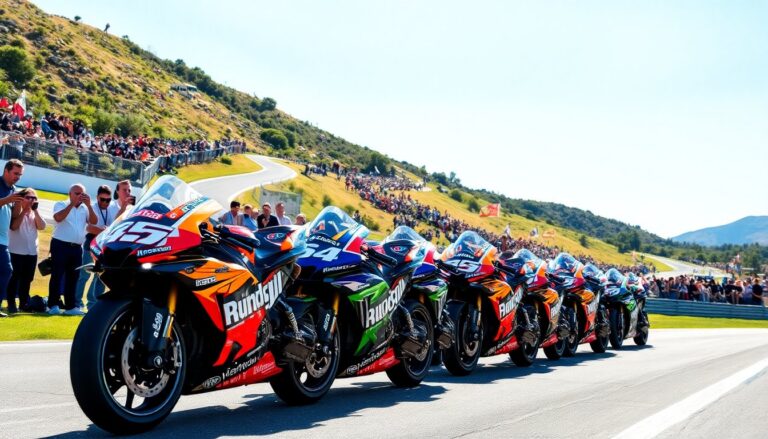Argomenti trattati
Understanding the allure of MotoGP
The MotoGP Championship stands out for its exhilarating races, innovative technology, and dedicated fanbase. As the leading category of motorcycle road racing, MotoGP has engaged audiences worldwide since its establishment in 1949. This article explores the sport’s history, the advanced technology behind the motorcycles, and the key figures who contribute to its excitement.
The history of MotoGP
Initially known as Grand Prix motorcycle racing, MotoGP has undergone substantial evolution since its inception. The sport began in 1949 with a limited number of races and manufacturers. However, advancements in motorcycle technology and rising public interest led to an expansion in both races and competitors.
In the late 1990s, MotoGP experienced a pivotal change with the introduction of four-stroke engines, which replaced the traditional two-stroke models. This transition not only enhanced performance but also introduced greater complexity to the machines, resulting in more exhilarating races. Today, MotoGP showcases a variety of manufacturers, including Yamaha, Honda, Ducati, and Suzuki, all striving to develop the fastest and most advanced motorcycles.
Technology in MotoGP
The technology utilized in MotoGP motorcycles exemplifies cutting-edge engineering. Each bike represents a culmination of extensive research and development, challenging the boundaries of speed and handling. Notable innovations include advanced electronic systems, lightweight materials, and refined aerodynamics.
Electronic systems
A pivotal advancement in MotoGP is the integration of advanced electronic control units (ECUs). These systems oversee various bike functions, such as throttle response, traction control, and anti-lock braking systems (ABS). The incorporation of these electronic systems enables riders to sustain optimal control in demanding conditions, thereby enhancing both safety and performance.
Aerodynamics
Aerodynamics plays a vital role in MotoGP technology. Teams dedicate substantial resources to wind tunnel testing and computational fluid dynamics. These efforts aim to refine the shape of their motorcycles. By optimizing aerodynamics, teams can effectively reduce drag and enhance stability at high speeds. Consequently, MotoGP motorcycles achieve speeds exceeding 350 km/h (217 mph) on straightaways, delivering an exhilarating experience for fans and riders alike.
The riders of MotoGP
The riders in MotoGP are not only athletes; they embody the art of speed and precision. Each rider showcases a distinct combination of skills and personality, contributing to the sport’s dynamic nature. Iconic figures such as Valentino Rossi, Marc Márquez, and Jorge Lorenzo have secured their places in racing history, each playing a pivotal role in the sport’s evolution.
These riders encounter significant physical and mental hurdles. The rigorous demands of racing require them to exhibit exceptional reflexes, endurance, and tactical acumen. Furthermore, the psychological component of racing is crucial; riders must continually assess their rivals and make instantaneous decisions throughout the race.
The passion of fans
MotoGP transcends its riders and technology; it thrives on the fervor of its fans. The atmosphere at a MotoGP race is charged, with thousands gathering to witness the high-speed action. The camaraderie among fans, vibrant team colors, and the thunderous roar of motorcycles create an unparalleled experience.
The sport enjoys a global following, with races hosted in various locations, from Italy’s historic tracks to modern circuits in Asia and the Americas. This international appeal not only underscores the sport’s rich heritage but also cultivates a sense of community among fans around the world.
The enduring appeal of MotoGP
MotoGP stands as a premier spectacle in motorcycle racing, where history and cutting-edge technology converge with remarkable human skill. This championship captivates both devoted fans and newcomers alike, presenting a thrilling experience that transcends mere competition.
The sport’s blend of speed, strategy, and innovation offers an engaging environment for enthusiasts. As technology advances and new riders make their mark, the excitement surrounding MotoGP is poised to continue, drawing in audiences for years to come.
With each race, MotoGP not only showcases the athletic prowess of its participants but also serves as a platform for technological advancements that push the boundaries of performance. The dynamic nature of the championship ensures that it remains a focal point in the motorsport world, appealing to a diverse audience.

